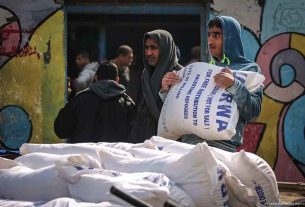![]() Satellite images show hundreds of trucks waiting at Rafah border crossing. Maxar Technologies/AFP Photo]
Satellite images show hundreds of trucks waiting at Rafah border crossing. Maxar Technologies/AFP Photo]
Fri 23 February 2024:
Over the past days, the Sinai Foundation for Human Rights has published three reports accompanied by videos and photos from the buffer zone in North Sinai, a few kilometres from the Egyptian border with the Gaza Strip and the Occupied Territories.
The issue began on 4 February, when the Egyptian army, accompanied by engineers from engineering companies contracted by the Abnaa Sinai Company, owned by the head of the Sinai Tribes Union, Ibrahim Al-Organi, moved loaders and vehicles to begin bulldozing and construction operations in a 13 kilometre-area inside the buffer zone, at an unusually rapid pace. The pictures also showed the construction of a huge seven-metre-high wall.
A day later, several Western websites, such as The Wall Street Journal, The New York Times, The Washington Post, The Guardian, Reuters and AP published reports accompanied by satellite images, all confirming what the Sinai Foundation had stated. Everyone was looking for an answer to one question: Is Egypt preparing to receive the displaced Palestinians from the Gaza Strip in Sinai after Israel begins the military operation in the Palestinian Rafah?
The Egyptian regime did not wait long before issuing its response quickly, not once, but four times, with four different official narratives, and you can choose whichever you want from them.
The first narrative came from Major-General Mohamed Abdel Fadil Shousha, the Governor of North Sinai, on 15 February, when he spoke to the Saudi Al Arabiya website, saying that there is no intention to displace Palestinians to Sinai, and that the ongoing works in the buffer zone are nothing but committees from the governorate that are counting the numbers of homes that were demolished in this area during the war on terrorism to determine the appropriate compensation from the State to the people of Sinai who were displaced from their homes years ago.
The problem with this story is that the people of Rafah and Sheikh Zuweid have already been demonstrating for months to demand their return to their homes and land, which the Egyptian authorities have been refusing and even dealing with by using a strong security fist. The Egyptian authorities have been arresting the most prominent figures from the Sinai tribes who are demanding the right of return. So why did the Egyptian authorities suddenly and without warning decide to allow them to return and even compensate them?
The second narrative came from Diaa Rashwan, head of the State Information Service, who said in two phone interviews that Egypt has no intention of receiving the Palestinians and that the buffer zone has existed for years and there is nothing new about it, so why should Egypt establish a new buffer zone?
The issue began on 4 February, when the Egyptian army, accompanied by engineers from engineering companies contracted by the Abnaa Sinai Company, owned by the head of the Sinai Tribes Union, Ibrahim Al-Organi, moved loaders and vehicles to begin bulldozing and construction operations in a 13 kilometre-area inside the buffer zone, at an unusually rapid pace. The pictures also showed the construction of a huge seven-metre-high wall.
A day later, several Western websites, such as The Wall Street Journal, The New York Times, The Washington Post, The Guardian, Reuters and AP published reports accompanied by satellite images, all confirming what the Sinai Foundation had stated. Everyone was looking for an answer to one question: Is Egypt preparing to receive the displaced Palestinians from the Gaza Strip in Sinai after Israel begins the military operation in the Palestinian Rafah?
The Egyptian regime did not wait long before issuing its response quickly, not once, but four times, with four different official narratives, and you can choose whichever you want from them.
The first narrative came from Major-General Mohamed Abdel Fadil Shousha, the Governor of North Sinai, on 15 February, when he spoke to the Saudi Al Arabiya website, saying that there is no intention to displace Palestinians to Sinai, and that the ongoing works in the buffer zone are nothing but committees from the governorate that are counting the numbers of homes that were demolished in this area during the war on terrorism to determine the appropriate compensation from the State to the people of Sinai who were displaced from their homes years ago.
The problem with this story is that the people of Rafah and Sheikh Zuweid have already been demonstrating for months to demand their return to their homes and land, which the Egyptian authorities have been refusing and even dealing with by using a strong security fist. The Egyptian authorities have been arresting the most prominent figures from the Sinai tribes who are demanding the right of return. So why did the Egyptian authorities suddenly and without warning decide to allow them to return and even compensate them?
The second narrative came from Diaa Rashwan, head of the State Information Service, who said in two phone interviews that Egypt has no intention of receiving the Palestinians and that the buffer zone has existed for years and there is nothing new about it, so why should Egypt establish a new buffer zone?
It is strange that Rashwan denied something that the Sinai Foundation did not mention, nor did Western press reports mention. No one claimed that Egypt was establishing a new buffer zone, and no one denied the existence of a buffer zone in the first place. Rather, they were talking about the strange construction that suddenly appeared in this area in coincidence with the Israeli military operation in Palestinian Rafah.
The third narrative came from Major-General Shousha, again, on 17 February, when he said in statements, also reported by the Saudi Al Arabiya website, that the Egyptian army is establishing a logistical area in that place to organise the waiting aid trucks and provide comfortable accommodation for the drivers of these trucks who have been waiting for months.
Major-General Shousha contradicted his first story with this second one, refuting and denying the first narrative. He also cast doubts on his credibility as an official source when he gave two different narratives, on two different days, to the same site. The question is why is the army establishing a logistical area after these trucks have been waiting for four months in front of the Rafah Crossing? What has changed?
What is more, the army put up a flimsy sign in front of that area reading “Logistical Area”, which Egyptian media outlets close to the regime were quick to broadcast this footage immediately to confirm the news and deny any talk or speculation about Egypt’s preparations to receive the Palestinians.
The fourth narrative came from Egyptian Foreign Minister, Sameh Shoukry, on the sidelines of his participation in the Munich Security Conference, where he said that Egypt has no intention of receiving the Palestinians and cannot allow the displacement of the Palestinian people from the Gaza Strip. He added that what is happening in the buffer border zone is nothing but maintenance work.
Honestly, I do not know what kind of maintenance work is needed for the desert sands in the buffer zone and why the army is building a wall that is 7 metres high, if the goal is maintenance work. Is it a logistical area, an inventory of the homes of the displaced or maintenance for something we do not know about on the Egyptian border?
The conflicting Egyptian narratives all prove what the Sinai Human Rights Foundation and Western press reports have said: Egypt is preparing to receive the Palestinians in the buffer zone in a place similar to cantons.
What are cantons?
A canton is a security and military-governed space subject to strict measures that can be imagined as an open-air prison for a group of people and is considered self-governed by its residents under a larger regional authority.
These cantons depend on external communication channels to obtain aid and do not have sufficient resources to rely on themselves for living, as they are established as alternative plans that provide security control and are subject to a strict siege from the higher regional authorities.
The cantons are considered an easy way to get rid of ethnic groups indirectly, as the Israeli Occupation implemented them on some people in the West Bank who were trapped in the middle of the settlements. The displaced Syrians also suffered from remaining inside these cantons that belong to different ethnic forces.
Historically, there has been the Cantonal rebellion in Spain, the canton system in Switzerland and the apartheid regime imposed in South Africa to continually disperse and weaken the population.
If Egypt adopts the same policy and places the Palestinians in these cantons, this will raise a set of important questions. For example, who would be responsible for them: the Egyptian armed forces or the militias of the Sinai Tribes Union and its head, Ibrahim Al-Organi?
When will these Palestinians return to their land again, and who decides how, when and where they will return? Will it be the Egyptian regime or Israel?
The Egyptian regime possesses the power cards that enable it to stop the entire Israeli war on the Gaza Strip and prevent the displacement plan once and for all, but it has chosen a policy of statements and declarations that Israel disregards, and a policy that will not stop the flow of Palestinians into the cantons of the buffer zone in North Sinai.

Osama Gaweesh
Osama Gaweesh is Editor-in-Chief at Egypt Watch and a TV presenter at Al-Hiwar. He has previously worked for Journalism.co.uk
This article appeared in Arabic on Arabi21 on 18 February, 2024.
______________________________________________________________
FOLLOW INDEPENDENT PRESS:
WhatsApp CHANNEL
https://whatsapp.com/channel/0029VaAtNxX8fewmiFmN7N22
![]()
TWITTER (CLICK HERE)
https://twitter.com/IpIndependent
FACEBOOK (CLICK HERE)
https://web.facebook.com/ipindependent
YOUTUBE (CLICK HERE)
https://www.youtube.com/@ipindependent
![]()
Think your friends would be interested? Share this story!






